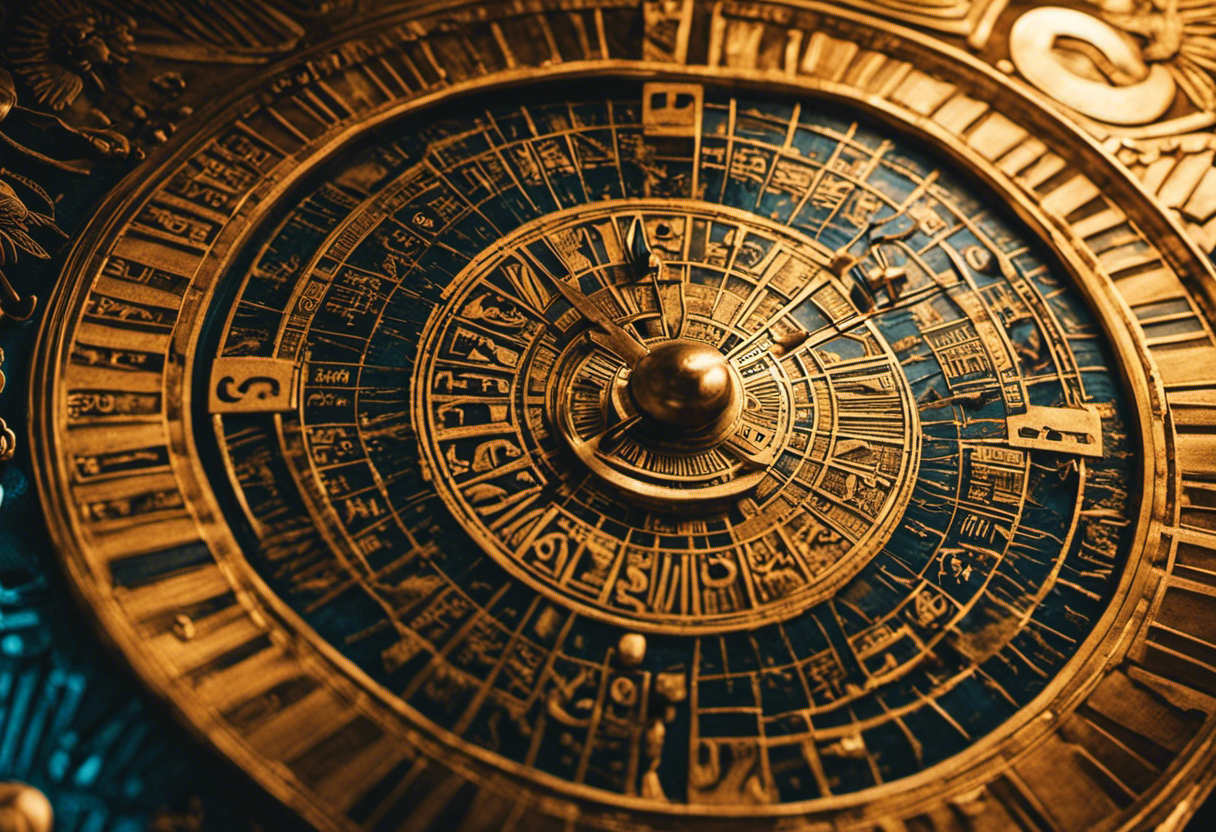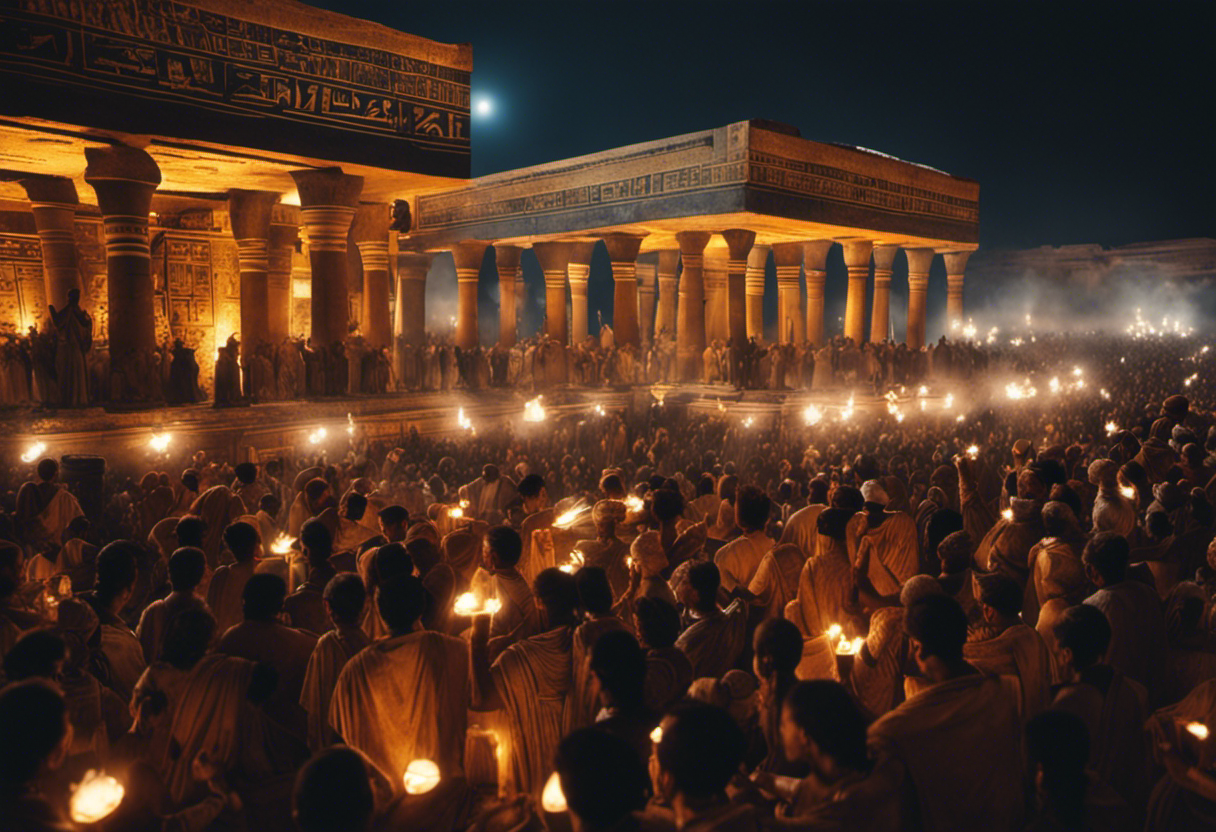In the intricate tapestry of Egypt’s rich cultural heritage, the ancient calendar stands as a testament to their profound understanding of time. Like a meticulously crafted sundial, this calendar weaves together the celestial movements, lunar cycles, and seasonal shifts to create a symphony of days, months, and seasons.
In this article, we delve into the depths of this fascinating structure, exploring its intricacies and uncovering the profound impact it has had on modern timekeeping systems. Join us on this scholarly journey as we unravel the mysteries of the Egyptian calendar.
Key Takeaways
- The Egyptian calendar combined lunar and solar elements to create a unique system, consisting of 12 months with 30 days each.
- The calendar included five additional days called ‘epagomenal days’ at the end of the year to align with the solar cycle.
- The division of hours and decans in the Egyptian calendar played a significant role in agricultural purposes, religious rituals, and astronomical observations.
- The Egyptian calendar recognized three main seasons: Akhet (flood season), Peret (growing season), and Shemu (dry season), which were crucial for agricultural practices and religious observances.
The Ancient Egyptian Calendar: A Historical Overview


The Ancient Egyptian calendar, with its unique system of days, months, and seasons, provides a fascinating glimpse into the historical and cultural development of the civilization. The calendar played a crucial role in the lives of the ancient Egyptians, influencing religious ceremonies, agricultural practices, and administrative tasks.
It was a lunar calendar, based on the cycles of the moon, with each month consisting of 30 days divided into three 10-day weeks called ‘decans.’ To align the lunar calendar with the solar year, the ancient Egyptians added five additional days at the end of the year, known as ‘epagomenal days.’ These days were considered outside of time and were associated with the birth of five important deities.
The ancient Egyptians divided the year into three seasons: Akhet (Inundation), Peret (Growth), and Shemu (Harvest). Akhet marked the flooding of the Nile, which was a vital event for agricultural productivity. Peret was the season of sowing and growth, while Shemu was the season of harvesting. Each season consisted of four months, making a total of twelve months in a year.
Overall, the Ancient Egyptian calendar was a sophisticated and intricate system that reflected the importance of astronomy, agriculture, and religious beliefs in their society. It provided a framework for organizing time and activities, which was essential for the functioning of their civilization.
The Structure of Egyptian Days: Hours, Wepet Renpet, and Divisions


Hours in the Egyptian calendar were divided into various segments, including Wepet Renpet and smaller divisions. The Egyptian day was divided into 24 hours, with each hour consisting of 60 minutes. The hours were further divided into smaller segments, known as decans, which were 10-degree divisions of the sky. Each decan corresponded to a specific star or constellation and marked the passage of time throughout the night. This meticulous division of time allowed the ancient Egyptians to accurately observe celestial events and track the movement of the stars.
To better understand the structure of the Egyptian calendar, let us take a look at the following table:
| Hour | Decan | Star/Constellation |
|---|---|---|
| 1 | 1st | Sirius |
| 2 | 2nd | Orion |
| 3 | 3rd | Pleiades |
| 4 | 4th | Ursa Major |
| 5 | 5th | Draco |
This table represents a small portion of the hours and decans in the Egyptian calendar. Each hour was associated with a specific decan and star or constellation, allowing the ancient Egyptians to accurately keep track of time and the changing seasons. This level of precision in timekeeping was crucial for agricultural purposes, as it helped determine the best times for planting and harvesting crops. Additionally, the division of hours and decans played a significant role in religious rituals and astronomical observations, showcasing the importance of time and its measurement in ancient Egyptian society.
Unraveling the Complexity of Egyptian Months: Lunar and Solar Cycles


Unraveling the complexity of Egyptian months involves understanding the interplay between lunar and solar cycles.
The ancient Egyptians used a lunisolar calendar, which means that their months were based on the phases of the moon, but also adjusted to account for the solar year.
This intricate calendar system allowed the Egyptians to align their religious festivals and agricultural practices with the celestial movements, highlighting the importance of astronomical influences in their culture.
Lunar Vs Solar
The distinction between the lunar and solar calendars is an important aspect to consider when examining the structure of the Egyptian calendar. The lunar calendar, based on the cycles of the moon, was used by many ancient civilizations including the Egyptians. In contrast, the solar calendar, based on the Earth’s orbit around the sun, was also employed by the Egyptians to track the seasons and agricultural activities.
To understand the differences between these two calendars, consider the following imagery:
-
Lunar Calendar:
-
The Egyptians observed the phases of the moon to determine the passage of time.
-
Each lunar month was divided into three 10-day weeks, with the remaining few days considered outside the calendar.
-
Solar Calendar:
-
The Egyptians used the annual flooding of the Nile to mark the beginning of their year.
-
The solar calendar consisted of 12 months, each with 30 days, and an additional 5 or 6 ‘epagomenal’ days to account for the difference between the solar and lunar cycles.
These distinctions highlight the complexity and adaptability of the Egyptian calendar in its effort to reconcile lunar and solar influences.
Complex Calendar System
To truly understand the intricacies of the Egyptian calendar, one must delve into its fascinating complexity and the way it seamlessly combines lunar and solar influences.
The Egyptian calendar was based on the cycles of both the moon and the sun, resulting in a unique system that accounted for the movements of celestial bodies. The calendar consisted of 12 months, each having 30 days, with an additional 5 or 6 days added at the end of the year to complete the solar cycle.
This combination of lunar and solar elements allowed the Egyptians to align their calendar with both the lunar month and the solar year. The calendar was carefully observed and maintained by priests who were skilled in astronomy and were responsible for intercalating the extra days at the end of the year to ensure that the calendar remained accurate.
This complex system highlights the Egyptians’ deep understanding and reverence for the celestial bodies and their role in the passage of time.
Astronomical Influences
Astronomical observations played a crucial role in the development and maintenance of the ancient Egyptian calendar. The Egyptians closely observed the movements of the sun, moon, and stars to determine the length of a year and the beginning of each month.
Here is a nested bullet point list illustrating the imagery of the Egyptian astronomers:
- They meticulously tracked the daily rising and setting of the sun, noting its position against specific landmarks.
- They used obelisks and temple alignments to mark the passage of time and determine the solstices and equinoxes.
- The precise observations allowed them to establish a solar year of 365 days, divided into 12 months of 30 days each, with an additional 5 or 6 epagomenal days.
The Importance of the Egyptian New Year: Wep Renpet and the Flood Season


During the flood season, the Egyptian New Year, known as Wep Renpet, held great significance in their calendar. The flood season, also known as Akhet, marked the annual flooding of the Nile River, which was a vital event for the agricultural livelihood of ancient Egypt. The floodwaters would bring nutrient-rich silt, replenishing the farmland and ensuring a bountiful harvest. As a result, the flood season and the New Year celebration were inextricably linked.
Wep Renpet was celebrated around mid-July, coinciding with the rising of the star Sirius, which was believed to signal the beginning of the flood. The New Year was a time of renewal and rebirth, both for the land and for the people. It was a time when the ancient Egyptians would make offerings to the gods, seeking their blessings for a successful flood and a prosperous year ahead.
The celebration of Wep Renpet involved various rituals and festivities, including feasting, music, dancing, and religious ceremonies. People would gather at temples and perform rituals to honor the deities associated with the flood, such as Hapy, the god of the Nile, and Osiris, the god of fertility and agriculture.
Overall, Wep Renpet held great importance in the Egyptian calendar as it marked the beginning of a new year, symbolizing the cyclical nature of life and the vital connection between the flood and the agricultural prosperity of ancient Egypt.
The Egyptian Seasonal Calendar: Akhet, Peret, and Shemu


The Egyptian seasonal calendar consisted of three main seasons: Akhet, Peret, and Shemu.
Each season held its own significance in the agricultural cycle and had distinct characteristics.
Akhet, also known as the flood season, marked the inundation of the Nile River and the renewal of the land.
Peret, the growing season, was a time of sowing and cultivation.
Shemu, the dry season, was characterized by hot temperatures and the ripening of crops.
Understanding the differences and significance of these seasons is crucial to comprehending the agricultural practices and cultural rituals of ancient Egypt.
Seasonal Calendar Significance
In the Egyptian calendar, the significance of the seasonal calendar is reflected in the agricultural activities and religious observances tied to each season. The Egyptians were highly dependent on the Nile River for their agricultural practices, and the changing seasons played a crucial role in determining the success of their crops.
The seasonal calendar consisted of three main seasons: Akhet (Inundation), Peret (Growth), and Shemu (Harvest).
During Akhet, the Nile would flood, depositing nutrient-rich silt onto the fields. This was a time of preparation for the upcoming planting season. Farmers would begin to repair and build canals and irrigation systems to channel the floodwaters to their fields. They would also worship the god Hapy, who was believed to control the flooding of the Nile.
In Peret, the floodwaters receded, leaving behind fertile soil. This was the time for sowing seeds and nurturing the growing crops. Farmers would carefully select and plant their crops, ensuring that they had enough water and nutrients to thrive. They would pray to the goddess Renenutet, who was associated with fertility and abundance.
Shemu was the harvest season, when the crops were ripe and ready to be gathered. This was a time of celebration and gratitude for the bountiful harvest. Farmers would gather their crops, carefully storing them for future use. They would offer thanks to the god Osiris, who was believed to govern the cycle of life and death.
Differences Among Akhet, Peret, and Shemu?
The significance of Akhet, Peret, and Shemu lies in their distinct agricultural activities and religious observances that corresponded to the changing seasons in the Egyptian calendar.
Akhet, also known as the inundation season, marked the flooding of the Nile River, which brought fertile soil to the fields. During this time, farmers would prepare their land for planting by clearing away debris and sowing seeds.
Peret, the growing season, was characterized by the cultivation of crops such as barley and wheat. Farmers carefully tended to their fields, ensuring that the plants received enough water and sunlight.
Shemu, the harvest season, was a time of reaping the rewards of their labor. The crops were harvested and stored, ensuring a steady food supply for the community.
Religious observances during these seasons included ceremonies to honor the Nile River and deities associated with agriculture, such as Osiris and Hathor.
Overall, Akhet, Peret, and Shemu were integral to the agricultural cycle and religious practices of ancient Egypt.
Festivals and Celebrations in the Egyptian Calendar: Honoring the Gods


Honoring the gods, festivals and celebrations played a significant role in the Egyptian calendar. The ancient Egyptians were deeply religious and believed in the power and influence of their gods in their everyday lives. Festivals and celebrations were held throughout the year to honor and appease these deities. These events were marked by elaborate rituals, processions, and offerings.
The festivals and celebrations in the Egyptian calendar can be divided into two main categories:
-
Solar festivals: These were based on the cycles of the sun and marked important agricultural and celestial events. One such festival was the Feast of the Valley, which celebrated the deceased pharaohs and was held on the west bank of the Nile. Another important solar festival was the Feast of the Wadi, which celebrated the flooding of the Nile and the subsequent fertility it brought to the land.
-
Lunar festivals: These were based on the cycles of the moon and were associated with specific gods or goddesses. One such festival was the Festival of Bastet, which honored the goddess Bastet and included music, dancing, and feasting. Another lunar festival was the Festival of Osiris, which commemorated the death and resurrection of the god Osiris and included processions and rituals at his temple in Abydos.
These festivals and celebrations were not only religious events but also important social and cultural gatherings that brought the Egyptian community together. They provided a sense of unity and identity, as well as an opportunity for people to express their devotion and gratitude to their gods.
The Legacy of the Egyptian Calendar: Influence on Modern Timekeeping Systems


The legacy of the Egyptian calendar can still be seen in many modern timekeeping systems used today. The Egyptians developed one of the earliest and most sophisticated calendars in history, which had a profound influence on subsequent civilizations. The Egyptian calendar was based on the cycles of the sun and the Nile River, with the year divided into 12 months of 30 days each, plus an additional five or six epagomenal days at the end of the year. This calendar structure, with its fixed number of days in a month, served as the foundation for other ancient calendars, such as the Roman calendar.
One of the most significant legacies of the Egyptian calendar is the concept of a 365-day year. The Egyptians observed that the star Sirius, known as the ‘Dog Star,’ rose just before the annual flooding of the Nile River, which marked the beginning of their new year. By closely monitoring this astronomical event, they were able to determine the length of a solar year with remarkable accuracy. This knowledge was later adopted by other civilizations and is the basis for the modern Gregorian calendar.
Another important legacy of the Egyptian calendar is the division of the day into 24 hours, with each hour divided into 60 minutes and each minute divided into 60 seconds. This system of timekeeping, known as the sexagesimal system, was used by the Babylonians and later adopted by the Greeks and Romans. It is still in use today, as evidenced by the 24-hour clock and the division of minutes and seconds.
Conclusion
In conclusion, the Egyptian calendar was a complex system that played a significant role in the lives of the ancient Egyptians. It consisted of a unique structure of days, months, and seasons, influenced by both lunar and solar cycles.
The calendar not only served as a means to track time but also played a crucial role in religious observances and agricultural activities. The ancient Egyptians believed that time was cyclical, and the calendar helped them align their daily lives with the natural rhythms of the universe.
Religious festivals and rituals were scheduled according to the calendar, with specific dates dedicated to honoring different gods and goddesses. These religious observances were important for the ancient Egyptians to maintain harmony with the divine and ensure the well-being of their society.
Furthermore, the calendar played a vital role in agricultural activities. The flooding of the Nile River was a significant event that marked the beginning of the agricultural season. The calendar helped the ancient Egyptians predict the annual flooding and plan their farming activities accordingly.
Despite its intricacy, the legacy of the Egyptian calendar can still be seen in modern timekeeping systems. The practice of dividing the year into 12 months, with each month having approximately 30 days, can be traced back to the Egyptian calendar. Additionally, the concept of a leap year to account for the extra quarter day in the solar year also originated from the ancient Egyptians.
Overall, the Egyptian calendar was not just a tool for measuring time but a reflection of the ancient Egyptians’ deep connection with nature and their religious beliefs. Its influence can still be felt in our modern-day calendars and timekeeping systems.




